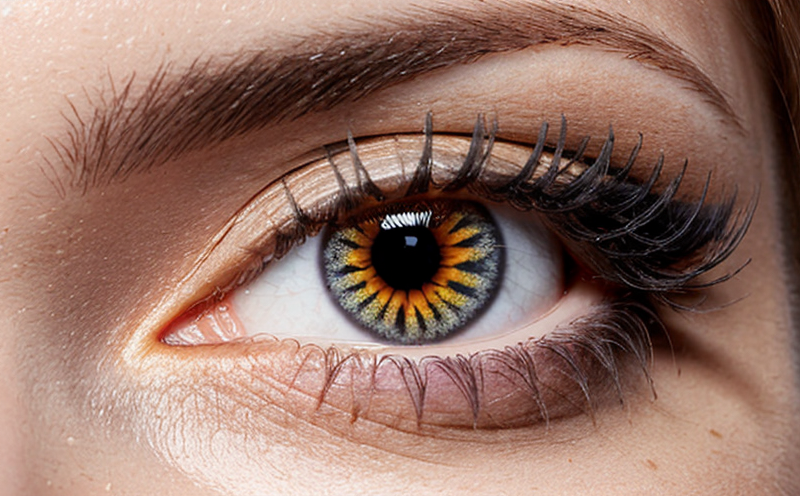Eye Irritation Testing of Mineral Eye Makeup
The testing of mineral eye makeup to determine its potential for causing ocular irritation is a critical aspect of cosmetics safety. This test is essential for ensuring that products meet regulatory standards and are safe for consumers. Regulatory bodies around the world, including those in the United States (FDA), Europe (EMA), and Asia (Japanese Pharmaceuticals Association) have stringent guidelines on the testing and labeling requirements for cosmetic products.
The primary purpose of eye irritation tests is to assess whether a mineral-based product causes adverse effects when applied directly to the eye. These tests are particularly important given that mineral makeup, which often contains natural ingredients like mica or iron oxides, can still pose risks if not properly formulated and tested. Eye irritation testing ensures that products meet safety standards set by international bodies such as ISO 10993-10:2018, which provides specific guidelines for ocular toxicity testing.
The test involves applying a small amount of the mineral eye makeup to the conjunctiva (the thin membrane covering the white part of the eye) or using an alternative method such as the use of an artificial tear solution. The application is done under controlled conditions, and the product's effects are observed over a set period, typically 4 hours for initial assessment. If no irritation occurs during this time, the test may be extended to up to 24 hours to ensure comprehensive results.
During testing, it is crucial that all procedures follow strict protocols to avoid any bias or error. The equipment used in these tests includes specialized contact lenses and artificial tear solutions designed specifically for such assessments. Safety precautions must also be taken by the testers to minimize risk exposure while conducting the examination.
The results from this test provide valuable information regarding the safety profile of mineral eye makeup products. Compliance officers, quality managers, R&D engineers, and procurement teams rely on these findings to ensure that their products are not only effective but also safe for consumers.
Industry Applications
The results from ocular irritation tests play a vital role in the development and approval of cosmetic products. Regulatory compliance is paramount, especially as new regulations continue to evolve. For instance, the EU's Cosmetics Regulation (EC) No 1223/2009 requires manufacturers to demonstrate that their products do not cause severe adverse effects on human health.
Quality managers use ocular irritation test results to ensure that all products meet regulatory standards and are safe for consumers. Compliance officers rely on these tests to stay ahead of changing regulations, ensuring that formulations comply with international standards such as ISO 10993-10:2018 or FDA guidelines.
R&D engineers can leverage the insights gained from ocular irritation testing to refine product formulas and improve safety profiles. By understanding which ingredients may cause adverse effects, they can make informed decisions about ingredient selection and formulation adjustments. Procurement teams also benefit from this data by ensuring that raw materials used in manufacturing meet stringent quality criteria.
In summary, ocular irritation tests are integral to the development process of mineral eye makeup products, providing crucial information necessary for regulatory compliance and enhancing product safety.
Why Choose This Test
- Ensures Compliance with International Standards: Adherence to ISO 10993-10:2018 ensures that your product meets global standards for ocular toxicity testing.
- Reduces Risk of Product Liability Claims: By conducting rigorous tests, you minimize the risk of legal action due to product-related injuries or illnesses.
- Promotes Consumer Trust: Demonstrating a commitment to safety and quality fosters trust among consumers who value transparency in manufacturing processes.
- Aids in Formulation Development: Understanding which ingredients may cause adverse effects helps R&D teams refine their formulations for improved safety profiles.
These advantages make ocular irritation testing an indispensable part of the cosmetics industry, ensuring that products are not only effective but also safe for use.
Competitive Advantage and Market Impact
- Enhances Brand Reputation: A strong safety record can significantly enhance a brand's reputation, attracting more customers and building long-term loyalty.
- Paves the Way for New Product Launches: Demonstrating compliance with rigorous testing protocols opens doors to new markets and opportunities for expansion.
- Improves Customer Satisfaction: Providing safe products enhances customer satisfaction, leading to higher repeat purchases and positive word-of-mouth recommendations.
By choosing ocular irritation testing, companies can gain a competitive edge in the market, stand out from competitors, and ensure that their products meet high safety standards. This not only benefits the company but also contributes positively to public health by promoting safer cosmetic practices.





